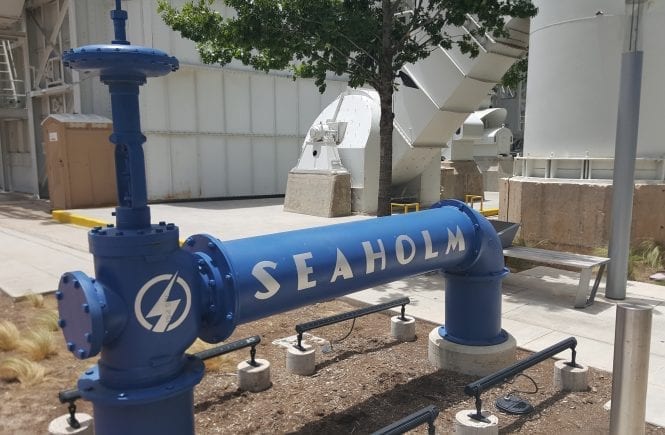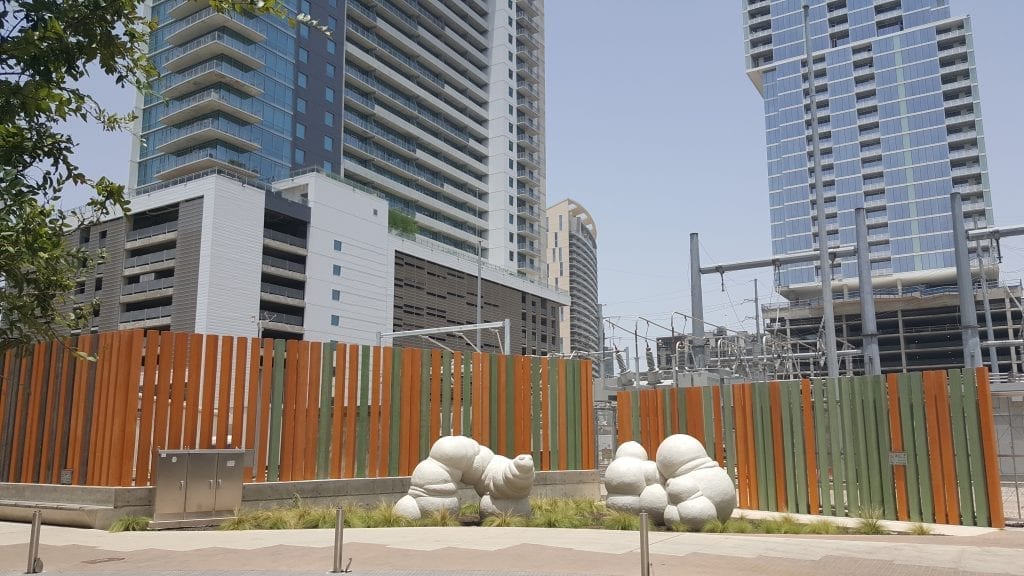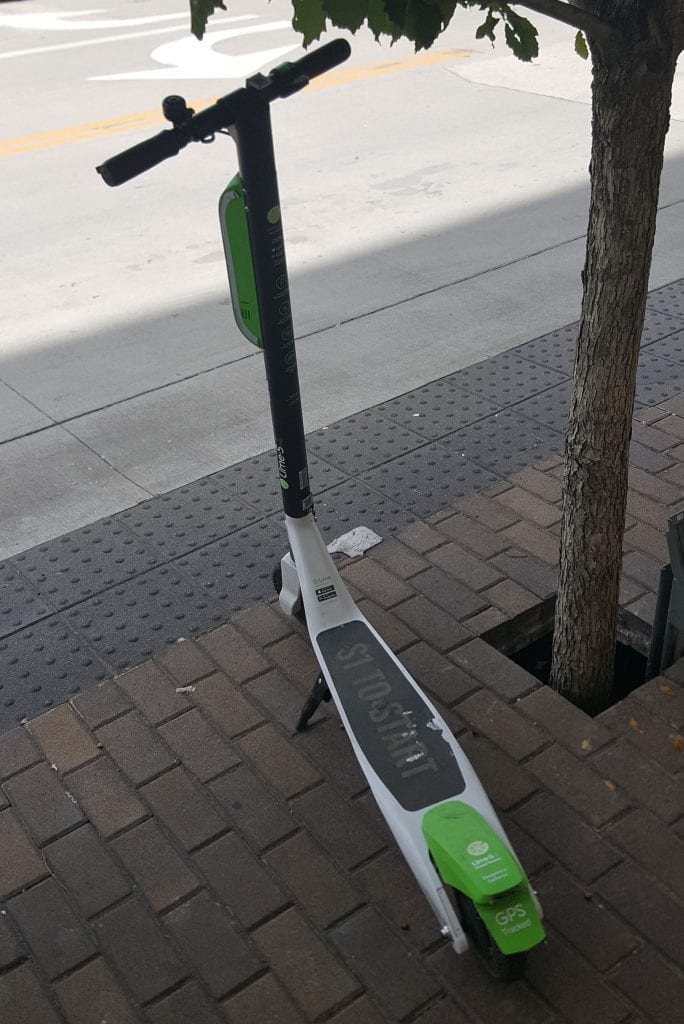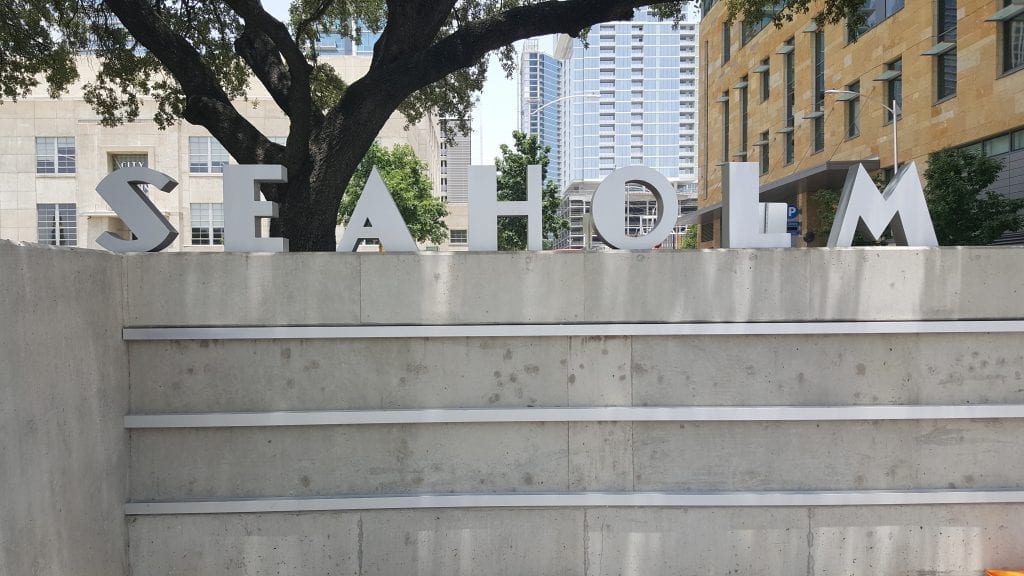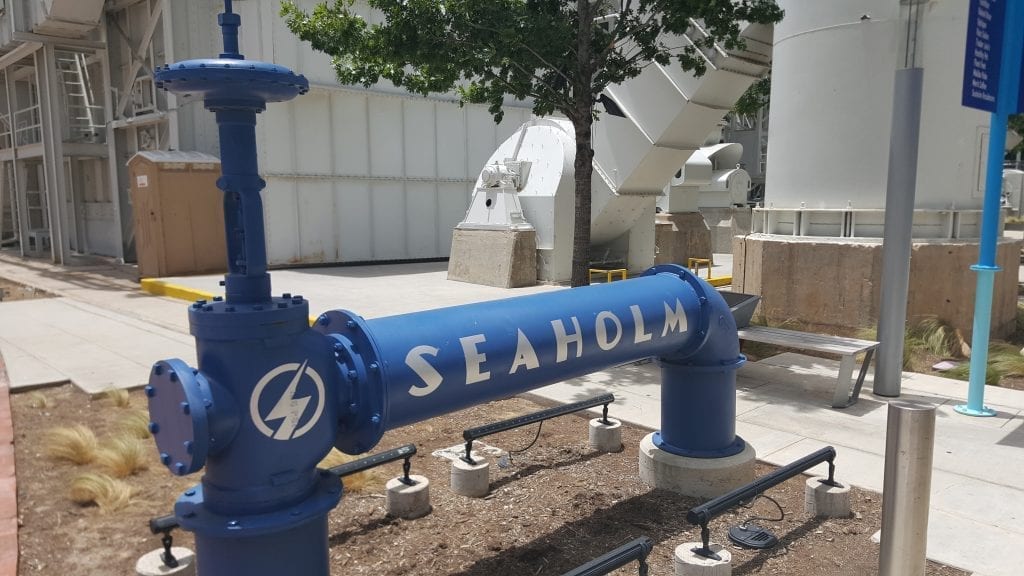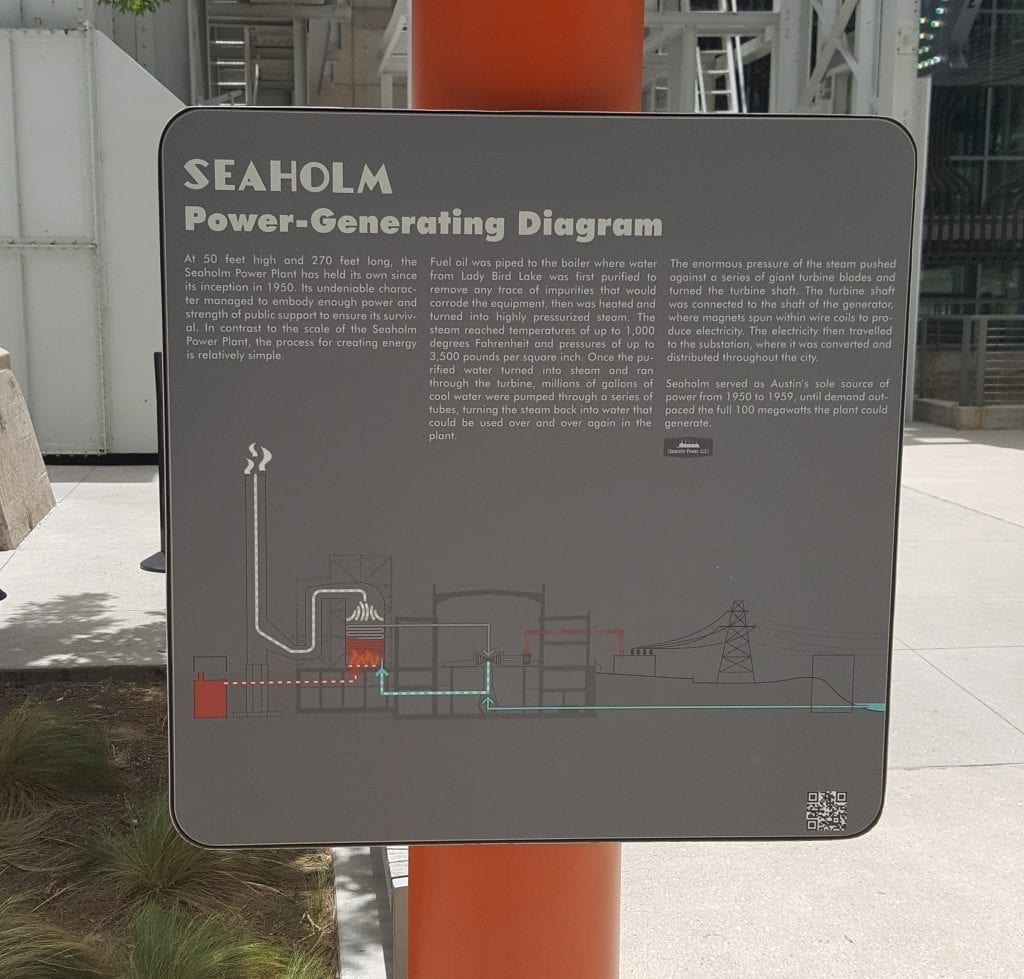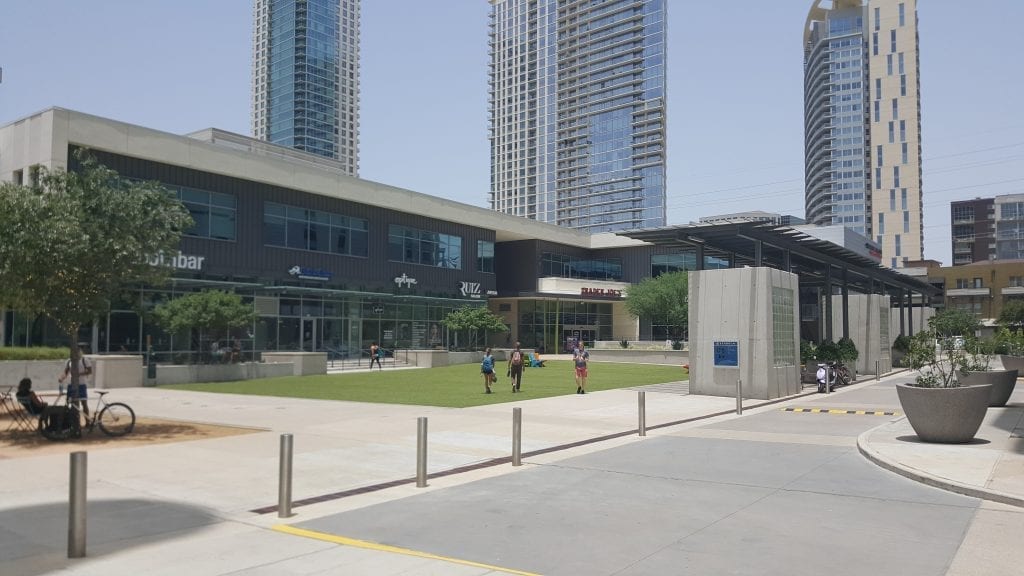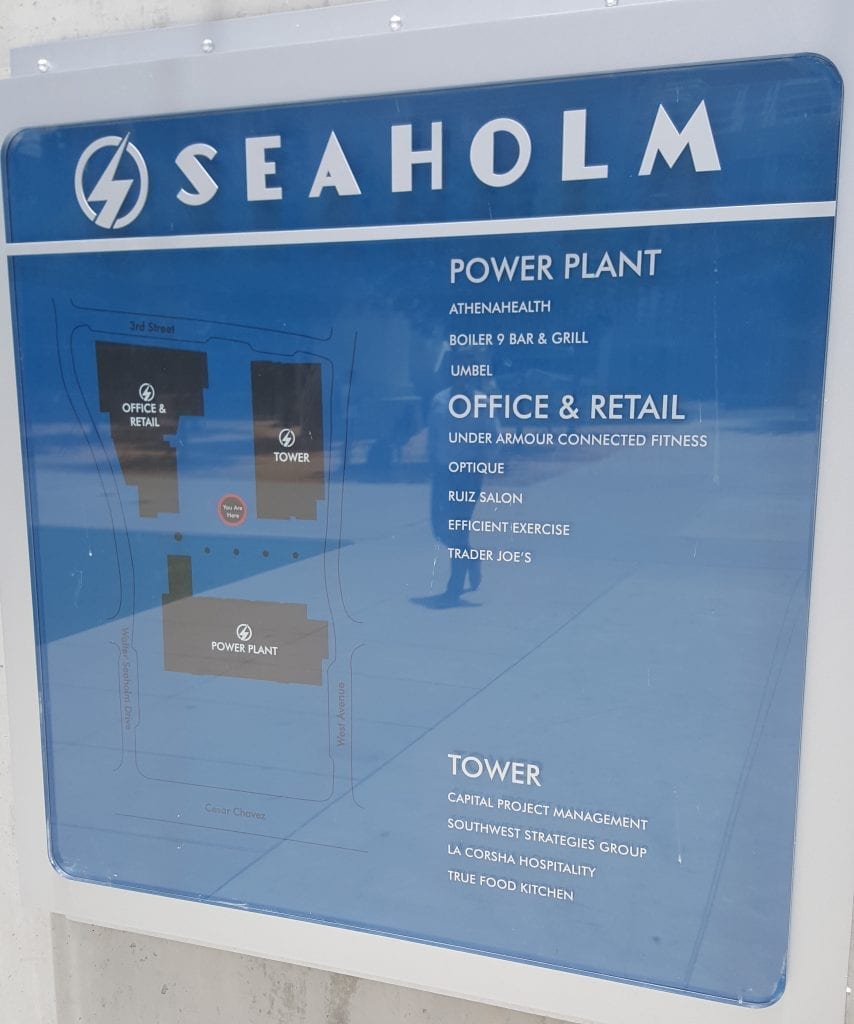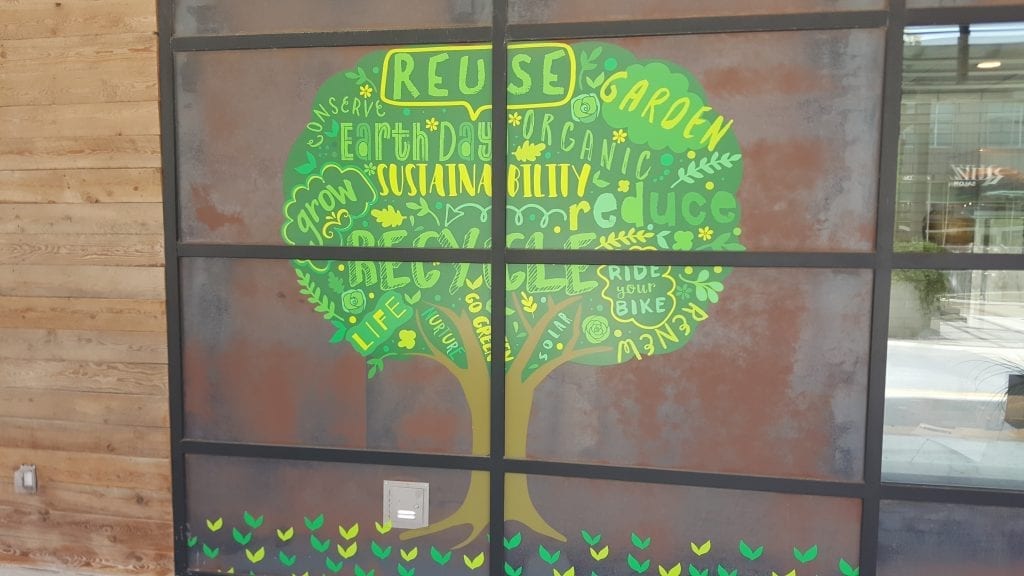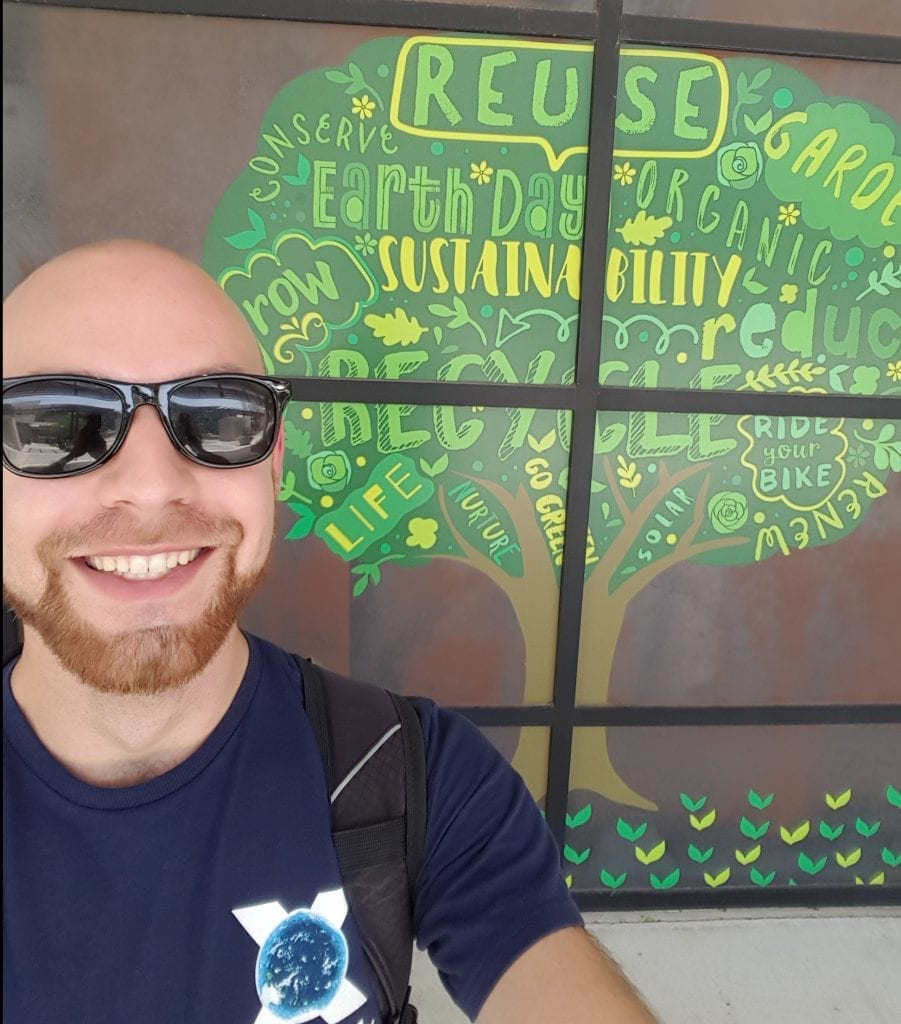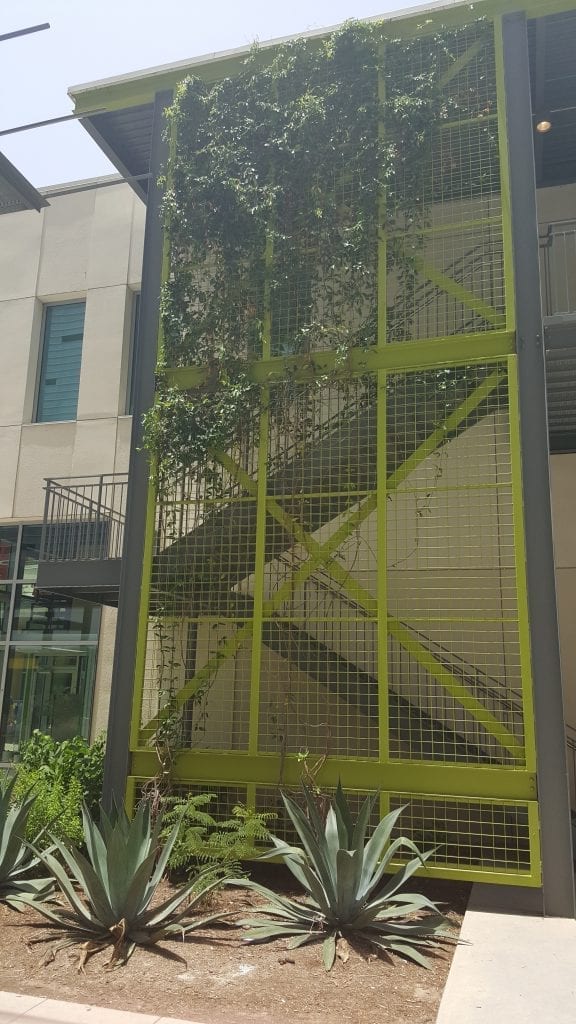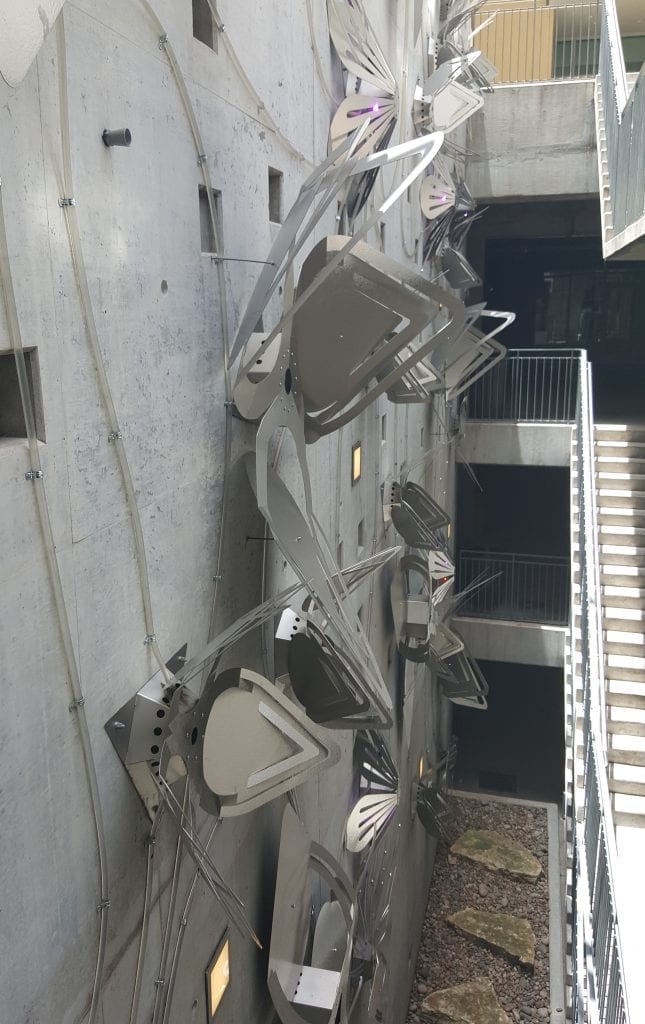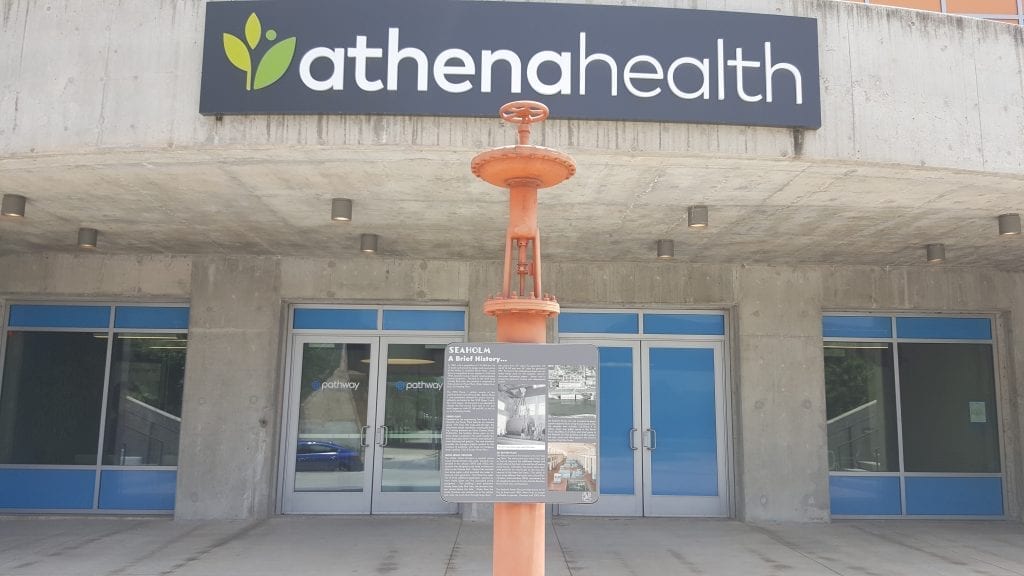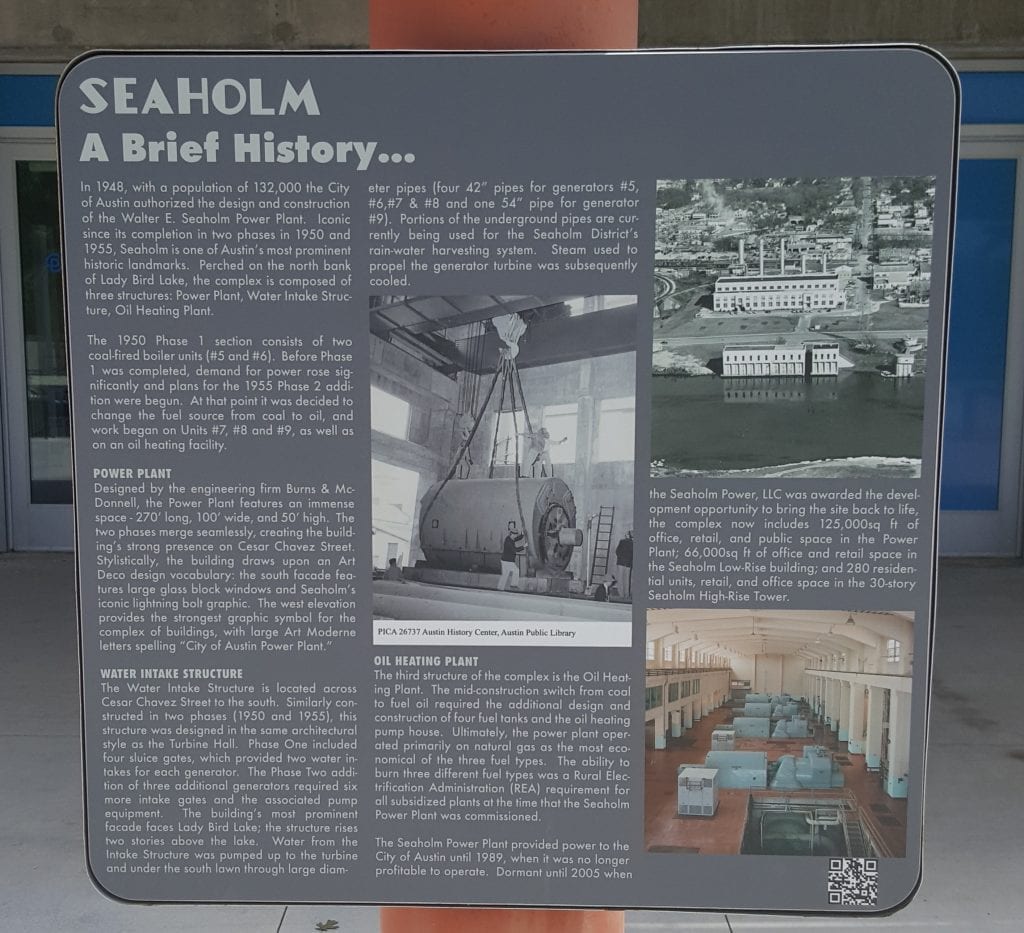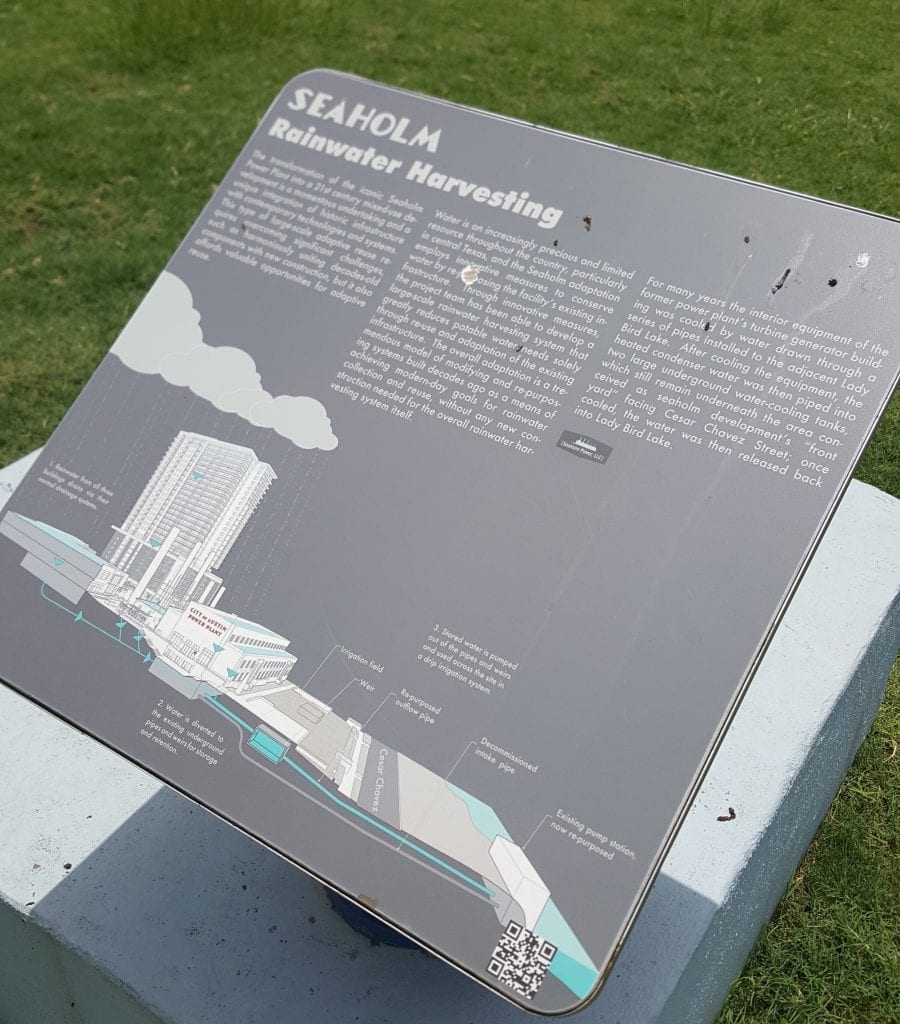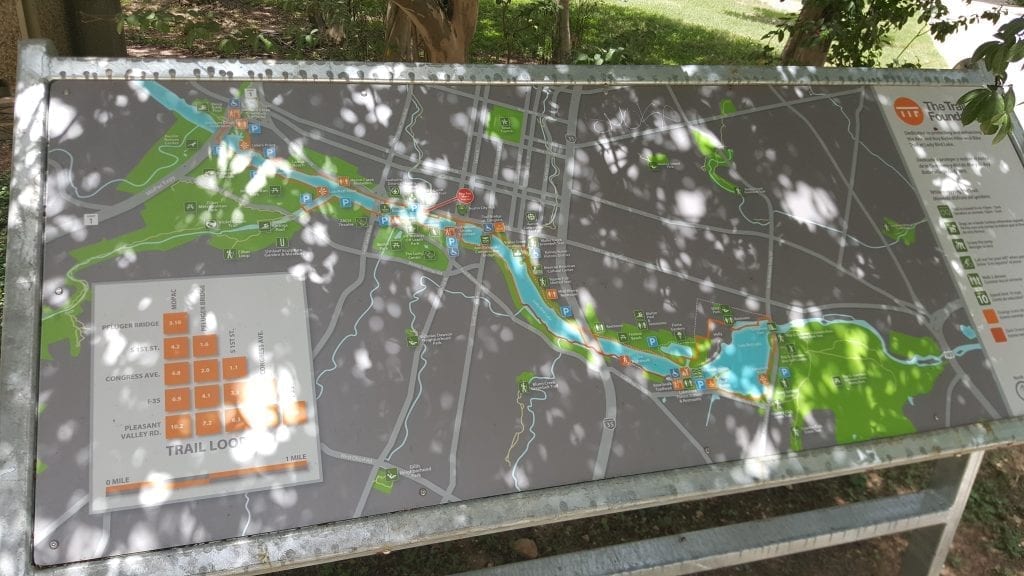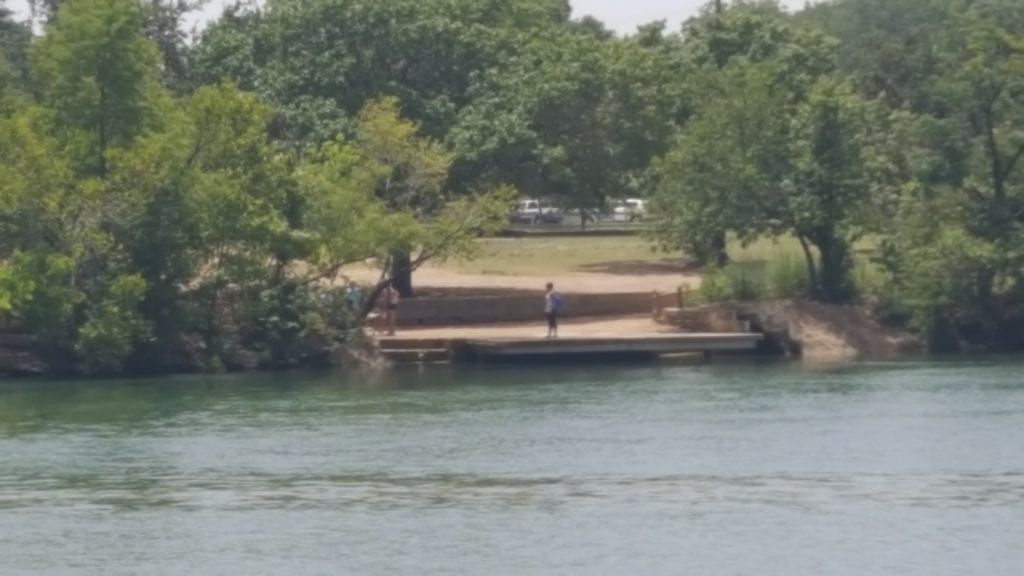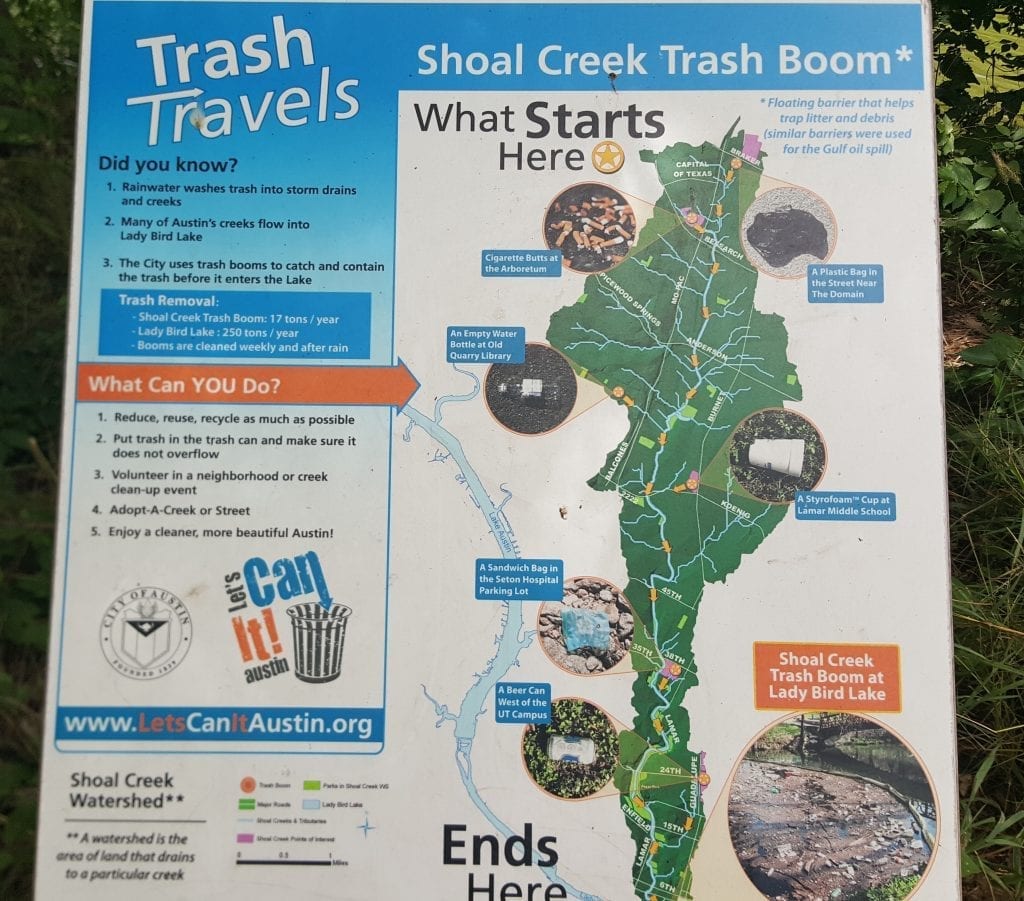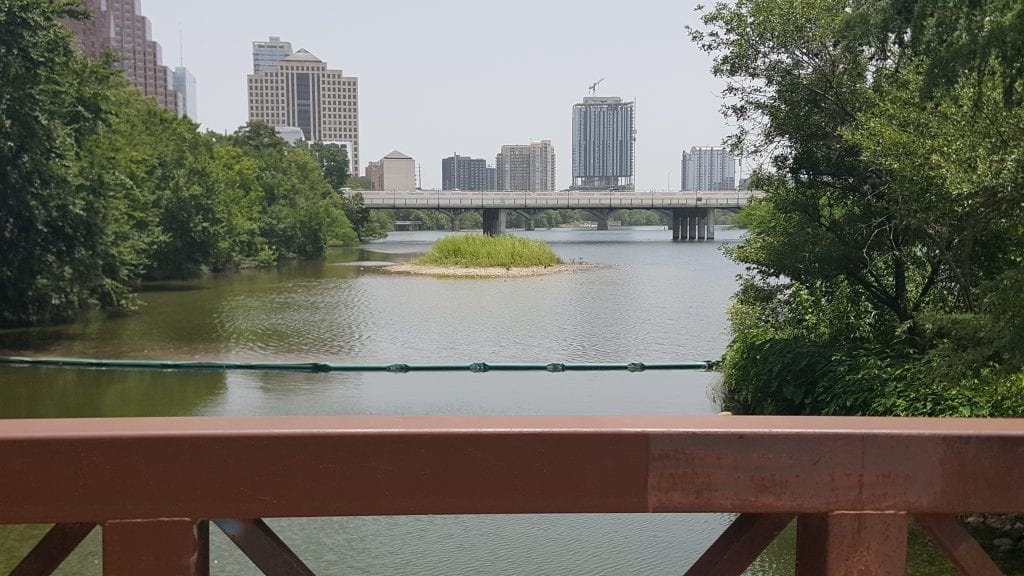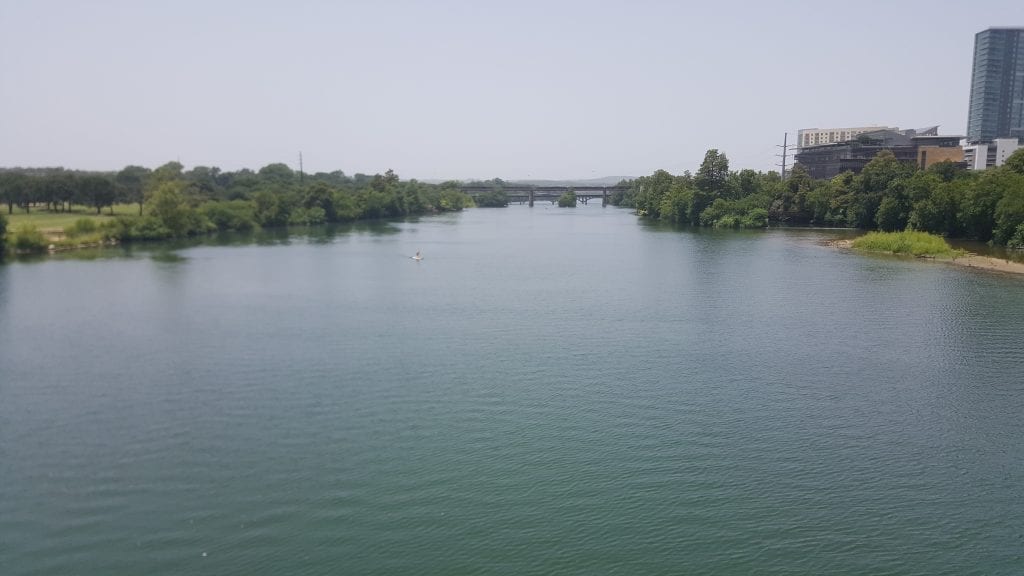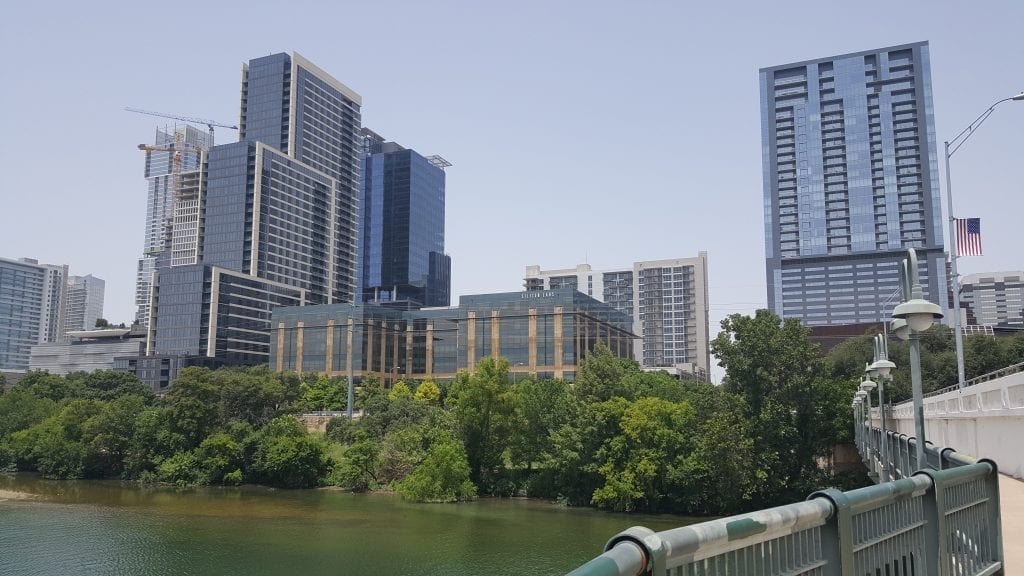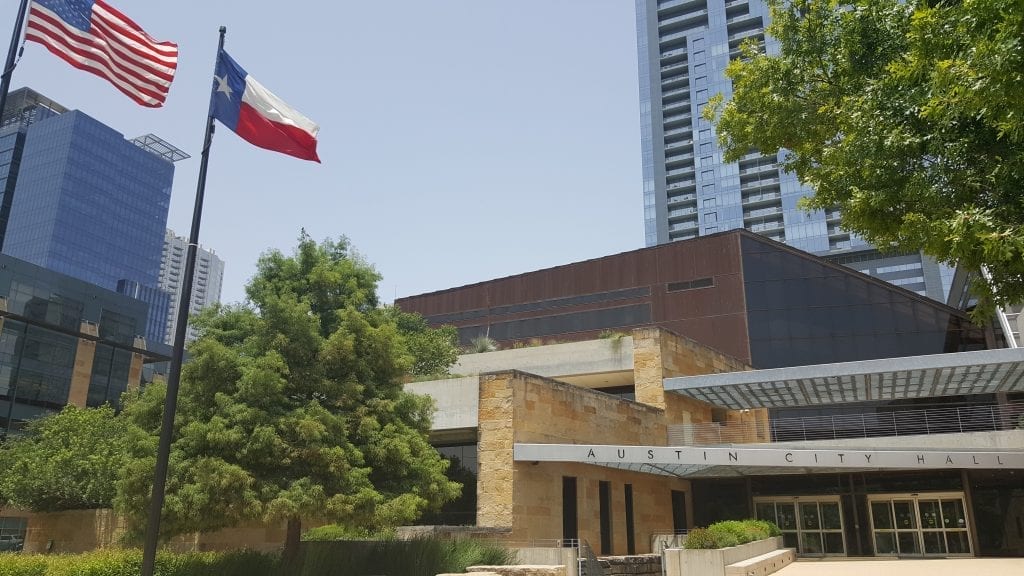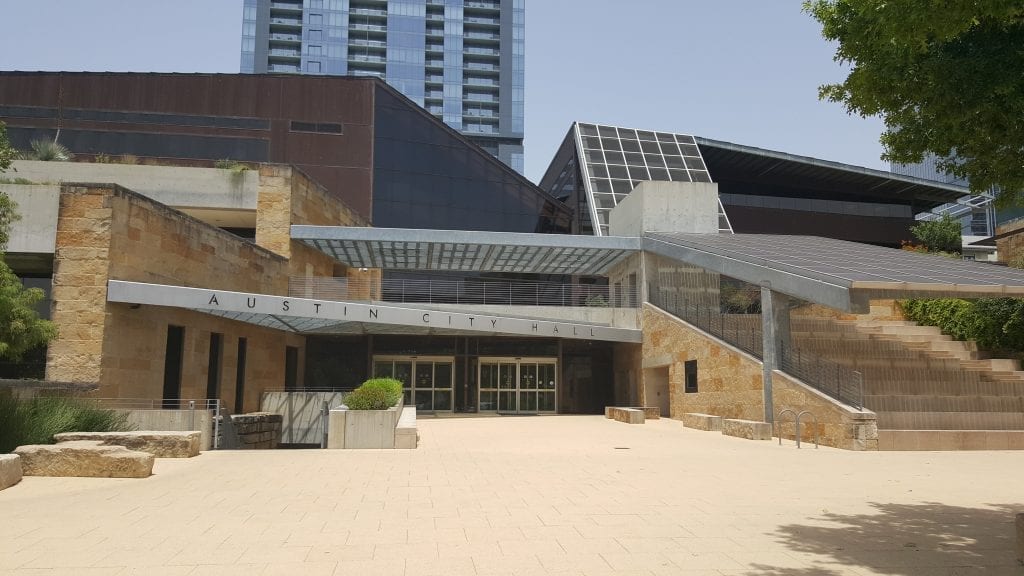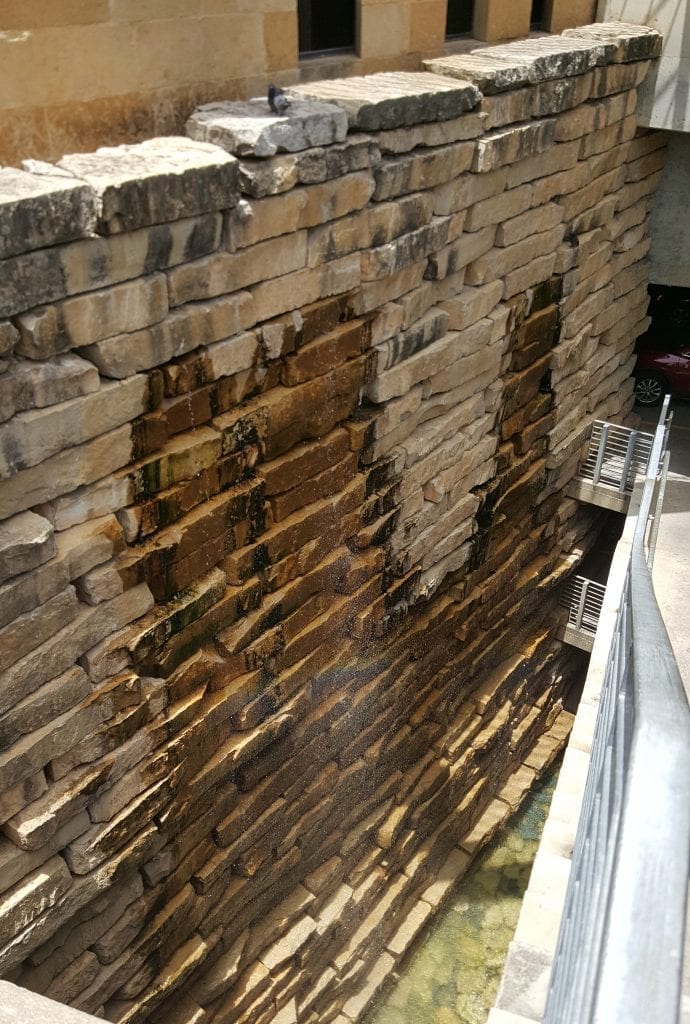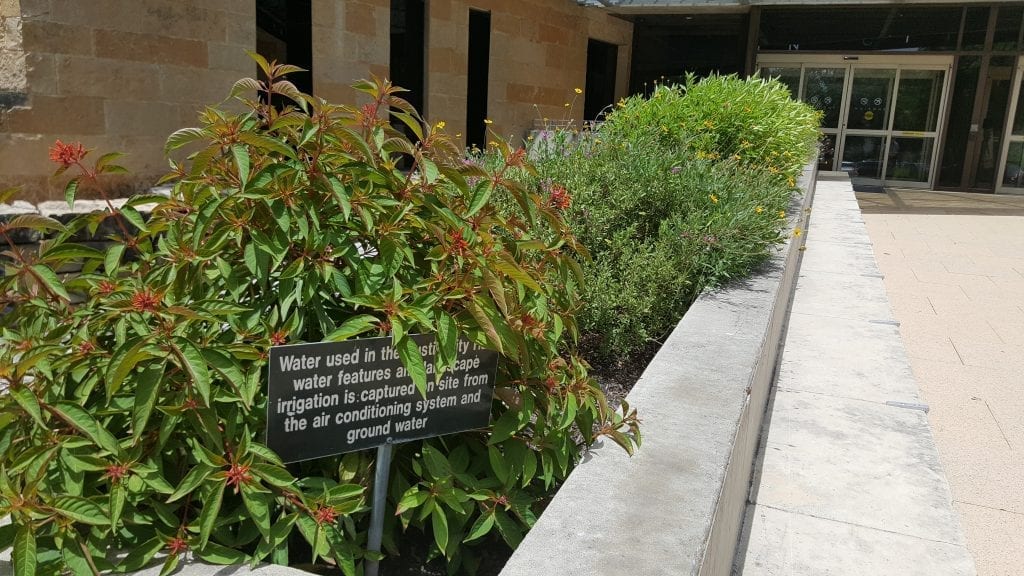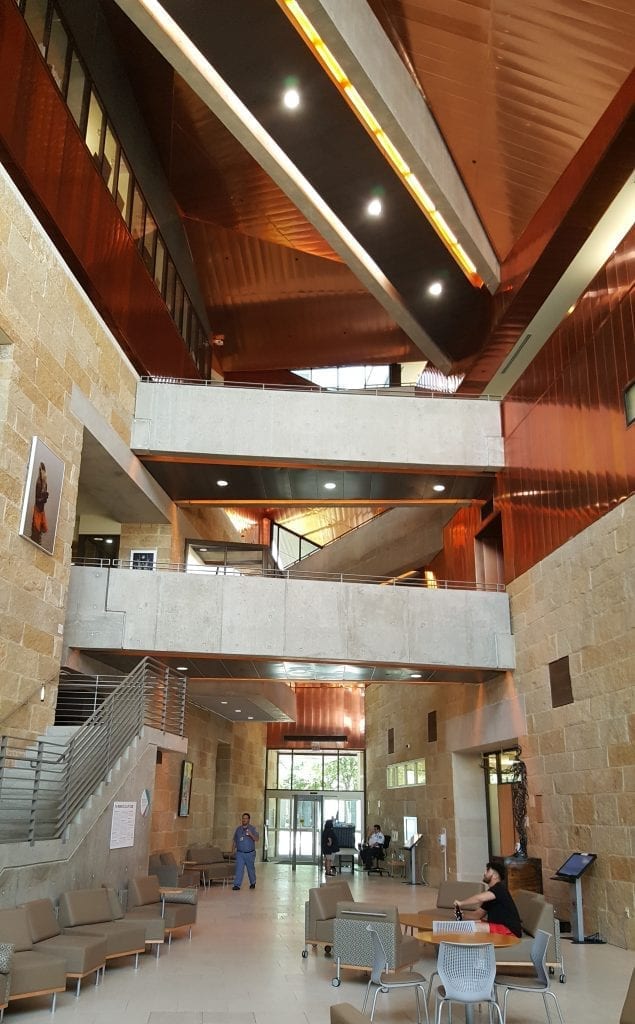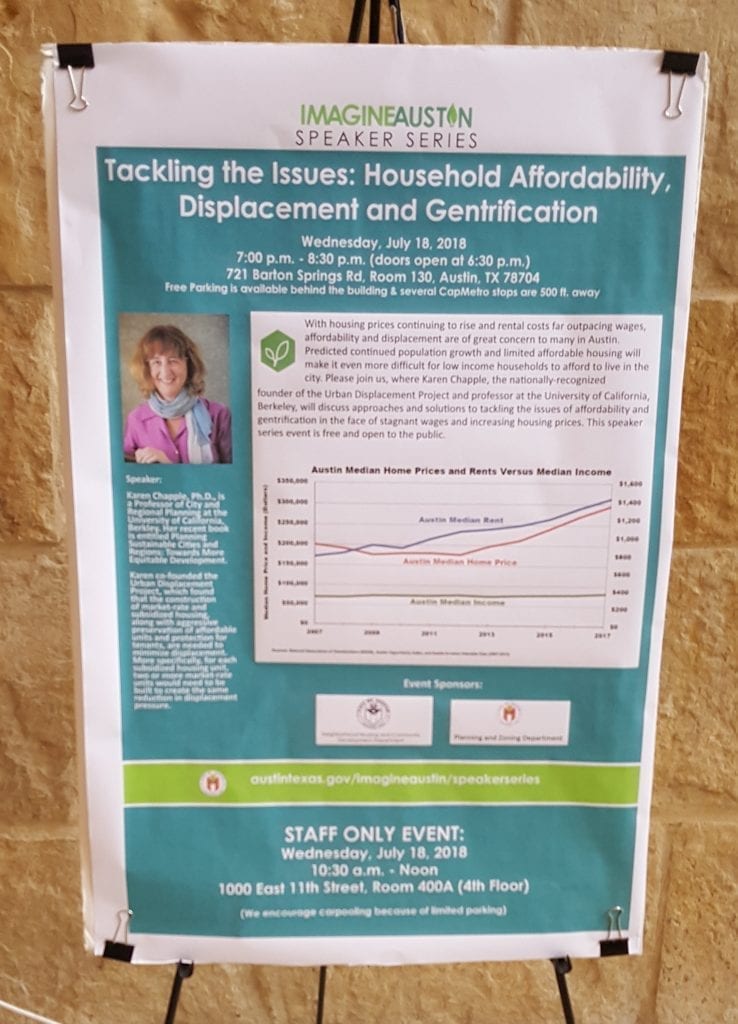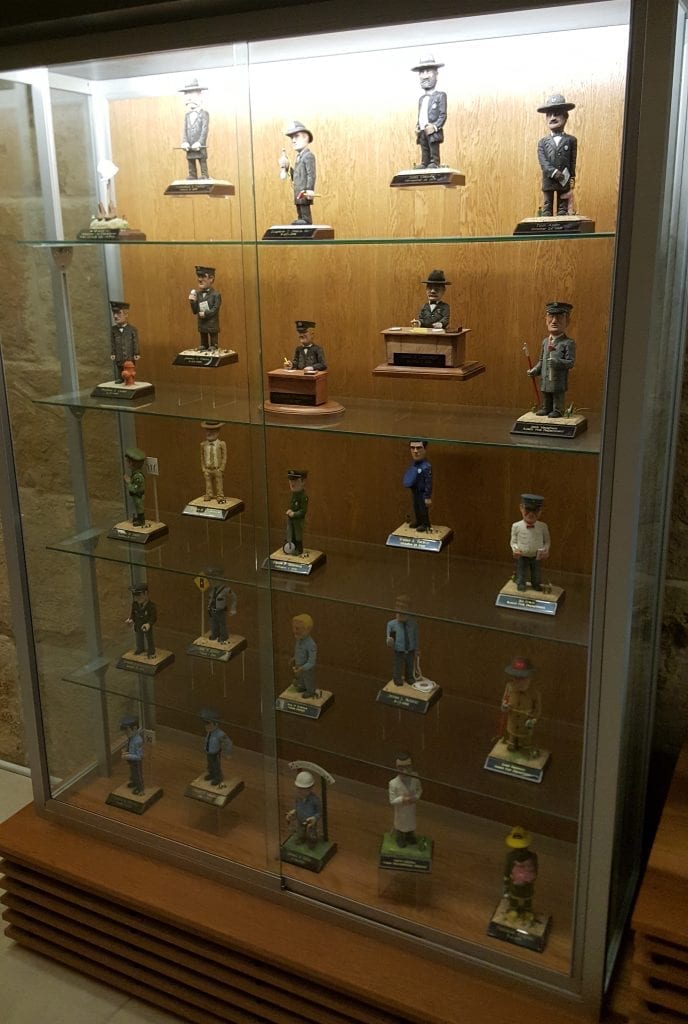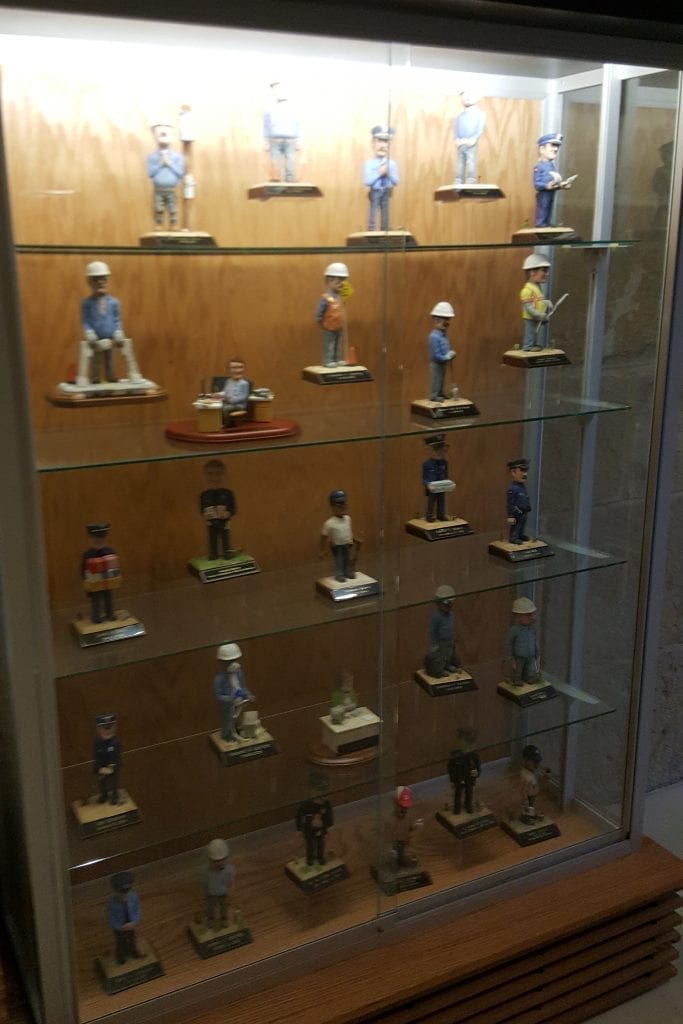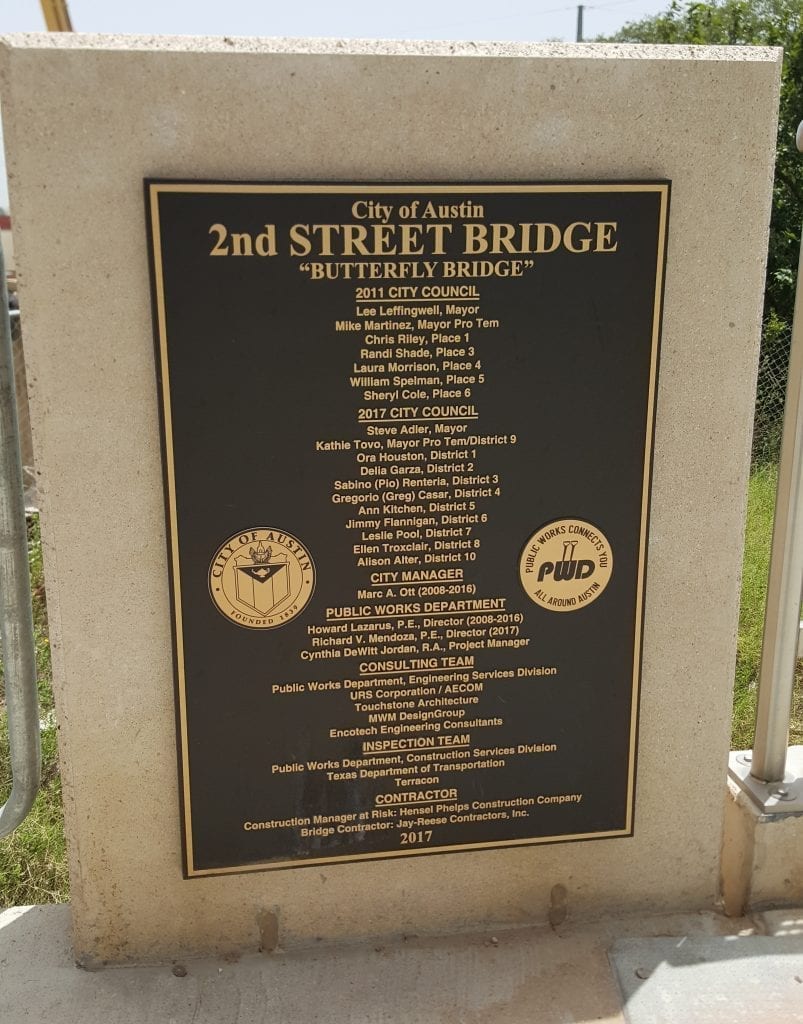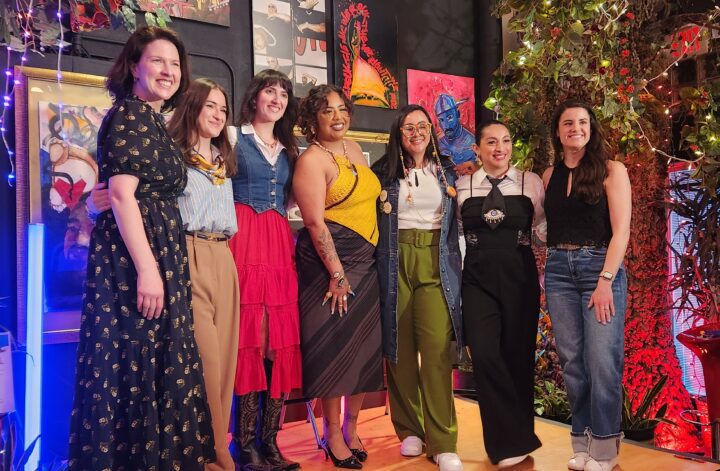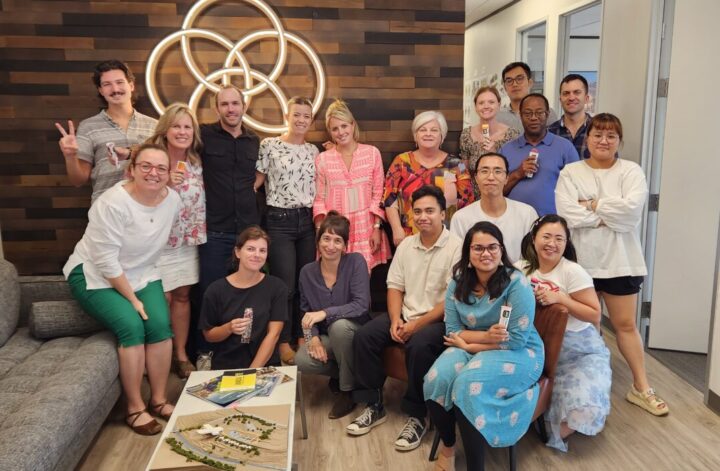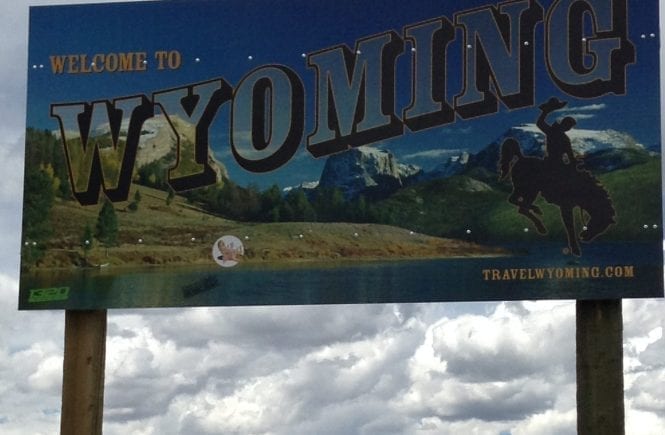The Seaholm EcoDistrict and Austin City Hall
After the Talk Green to Me presentation by Edwin Marty, Austin’s first Food Policy Manager, at the Austin Central Library, I walked around the Seaholm EcoDistrict and toward Austin City Hall to see some of the new sustainable developments and initiatives in the area.
“The iconic Seaholm Power Plant lends its name to the entire Seaholm EcoDistrict and symbolizes the revitalization of this prominent area in the heart of downtown Austin.
After the power plant was decommissioned in 1989, the property was designated as a brownfield site and was considered too contaminated for use. Between 1997 and 2003, significant investment was devoted to cleaning up the historic site, and in 2005 a public-private partnership was formed to redevelop the building using green design and construction practices.
Restoration of the power plant created a ripple effect of sustainable development surrounding the site and today the Seaholm EcoDistrict is a vibrant hub of residential, office, and community gathering spaces that reflects Austin’s spirit of originality and soul.” – City of Austin Webpage
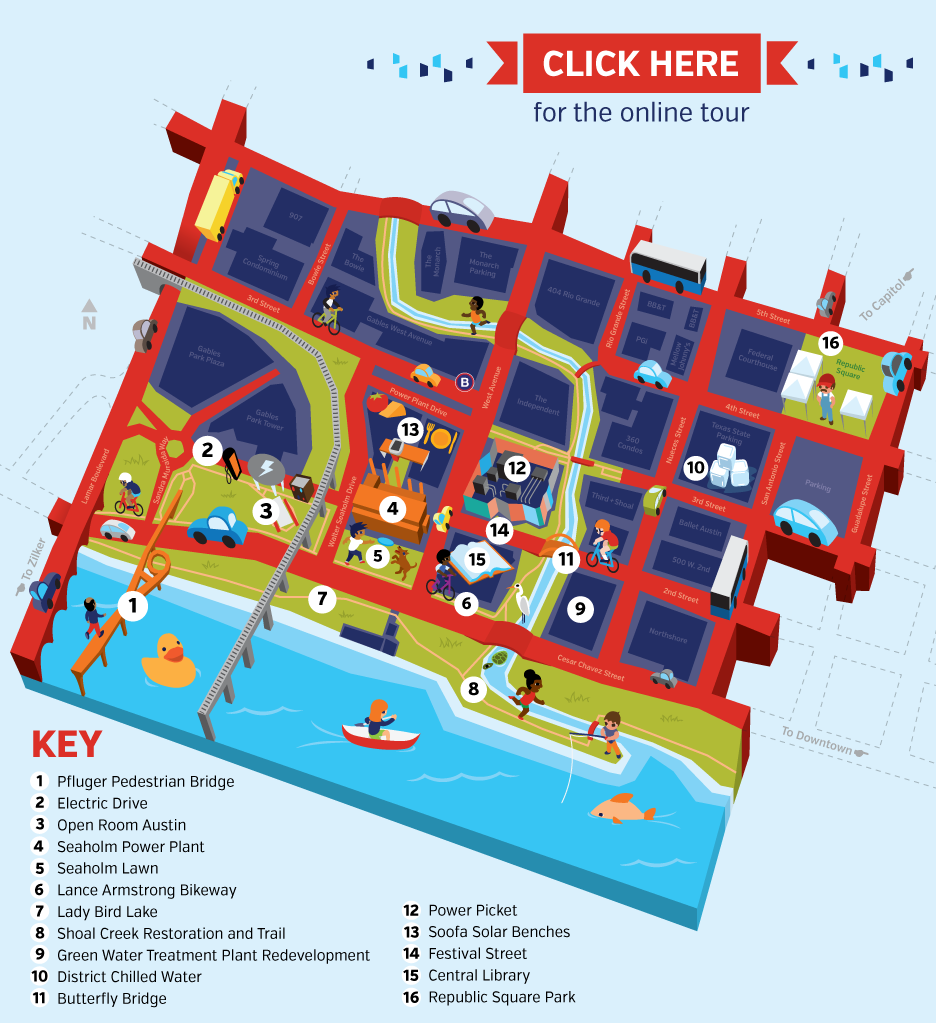
I left the library t0 walk around the Seaholm ecodistrict and came across this sculpture on the backside of the Austin Central Library just right on the outside of the District’s Austin Energy electric power substation colored fencing.
“Tall Solo, Big Mama Baby, and Little Mama are three sculptures by Texas artist Sharon Engelstein that make up the family group titled Crullers. Inspired by the many possible definitions of family, the creature-forms hint at the familiar while inviting interpretation and conversation. One viewer might see an animal, while another might see a spacecraft, or scoops of ice cream or a rock formation. The artist used steel armature, milled foam and pigmented glass fiber reinforced concrete to create these whimsical shapes. Taking inspiration from beloved animals, specifically elephants and hippopotamuses, the artist crafted form and texture to evoke the sense that these sculptures are creatures. Big Mama Baby and Little Mama are nestled together within soft grasses across from the new Central Library, patiently waiting for Tall Solo, who has “wandered away” to 3rd Street and West Avenue.” — Economic Development Department Webpage
I continued my walk and saw lots of people riding around on these green electric scooters, which reminded me a lot like the Dallas bike share programs that went belly-up recently. (After I returned to Dallas, I saw these scooters in and around the city too.) I think these scooters require less effort from the rider (standing vs peddling) which is why they are so popular in urban settings.
This is a picture of the Seaholm District sign on the Cesar Chavez intersection, right across from the Austin Central Library’s sign.
“The original Seaholm Power Plant Building paired with the other mixed use components is the anchor of the southwest quadrant of downtown. Built in the 1950’s and redeveloped in 2015, the iconic Seaholm Power Plant’s classic, art deco architecture mixed with unique, modern finishes construct a 4-story creative office/mixed use building including over 200,000 square feet of office, 280 condominiums and 50,000 square feet of highly desirable ground floor retail space with two large outdoor courtyards.
The lawn at Seaholm Power Project boasts functionality and flexibility as a downtown green space across the street from Lady Bird Lake and located in the sophisticated southwest quadrant of downtown. Framed by the Seaholm Power Plant Building, the lawn is surrounded by the area’s classic art deco architecture mixed with unique and modern finishes. The space, which can accommodate over 2,000 people, is currently open and accepting event reservations.” — Seaholm
LAWN SPECS
SIZE: 27,000 square feet | MAX CAPACITY: 4,000 | SEATED CAPACITY: 2,000
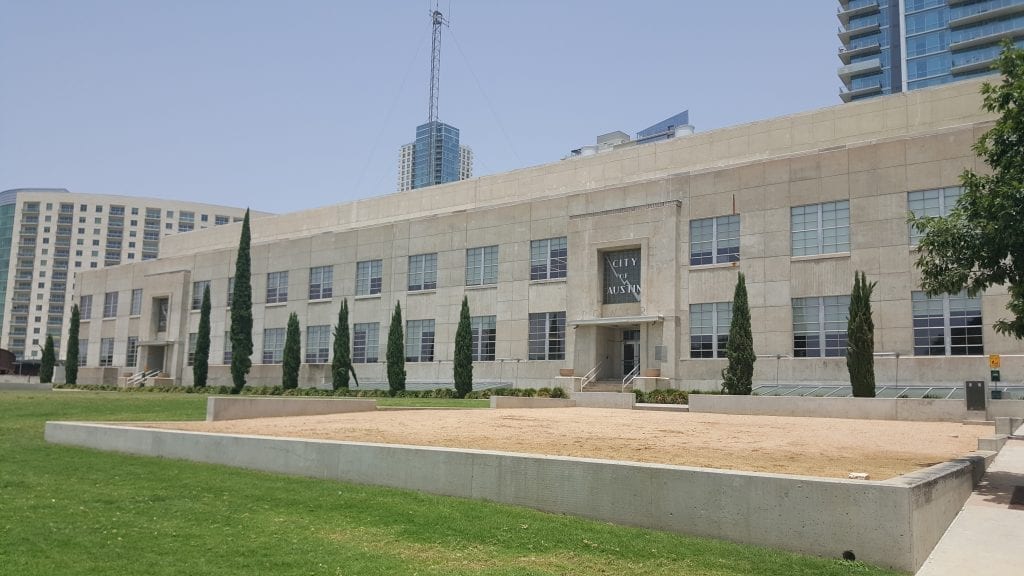
After checking out the front lawn of the Seaholm Power Plant, I went up the sidewalk and entered the heart of mixed-use commercial and residential courtyard. At the corner of the sidewalk was a salvaged piece of piping from the power plant that was painted blue and turned into an artistic sign for the district!
There were many of these informational plaques around the power plant, which included diagrams and historical excerpts about the buildings. This diagram highlights the power-generating process the plant used to draw water from Ladybird Lake to create steam that turned large turbines to generate electricity. The plant served as Austin’s sole source of power from 1950 to 1959, until the power demand outpaced the full 100 megawatts capacity!
Also in the Seaholm district were these Soofa benches that were part furniture, part cell phone charger! Other cities these benches are in include: Boston, Jersey City and Boulder
“Soofa Benches are “smart benches” designed by three graduate students from the MIT Media Lab and the Harvard Innovation Lab. The benches use solar panels to charge mobile devices, such as phone and tablets. Soofa benches can also sense the environment around them. They’re outfitted with a variety of sensors to collect data from air quality, sunlight, and use by the community.” — City of Austin Blog Post
For a better look at the immediate Seaholm EcoDistrict, I included a site map below highlighting the mixed-use commercial and residential space, along with the current businesses in place. (Image from Endeavor Real Estate)
This is a view of the main courtyard in the center of the commercial and residential plaza. Though the grass is artificial turf, it still sees a lot of foot traffic, occasional picnics, and plenty of playful pups running around!
This is a picture of the business directory on the covered seating pillar near the main central plaza, which you can also see in the image above. I was really impressed to see how three separate businesses could be put into the Power Plant building!
Another Seaholm plaque provided the history of the oil heating building that was used as part of the power plant for generating electricity. Though the building is no longer in existence, the Boiler 9 Bar & Grill pays a tribute to the building with it’s name and location next to the power plant!

One of the main restaurants in the Seaholm District is True Foods Kitchen, a relaxed, eco-chic chain serving health-conscious fare, including vegan options and cocktails, inspired by the philosophy that food should make you feel better, not worse.
I didn’t have time to eat at True Foods, but I did really enjoy the artistic mural on their window by their kitchen. So much so, that I even took a selfie with it!
Other features around the Seaholm ecodistrict included raised prairie grasses, small chairs and tables, and trellis grating along side the staircases for aesthetics and some privacy once it fills out.
Even the underground parking garage below the main courtyard featured a unique art installation!
“Golden Afternoon, by Urban Matter Inc. is a responsive public art installation in the parking structure of the Seaholm Redevelopment Project. Inspired by the wildflowers of Texas, the installation mimics a hanging garden that has overgrown from the flower beds on the plaza level, down the open stairwell, making its way into the parking structure. Reminiscent of a trip down the rabbit hole from Alice’s Adventures in Wonderland, the artwork experience is heightened by lighting which responds to people moving up and down the stairs.” — Economic Development Department Webpage
One of the other companies based in the former Seaholm Power Plant building is AthenaHealth, a business that provides digital support and services for electronic health records (EHRs) and other digitally-connected healthcare services.
This specific plaque outside of AthenaHealth is attached to salvaged original piping and provides a historical overview of the Walter E. Seaholm Power Plant. It laid dormant from 1989-2005, when it was revitalized for the current development of mixed-use commercial, office and residential space.
This diagram outlines how the rainwater collection system at the power plant works. And because it’s no longer a functioning power plant, the rain water collection tanks are tied to the Austin Central Library for water storage!
After I toured around the Seaholm ecodistrict stops, I walked over to the Ladybird Lake walking trail maintained by The Trail Foundation, a nonprofit dedicated to protecting, enhancing, and connecting the Butler Hike-and-Bike Trail at Lady Bird Lake.
“Recently, The Trail Foundation established criteria by which its projects are selected. These criteria centered around two focus areas: 1) Community need and benefit, and 2) TTF’s capacity and ability to complete the projects. With this criteria in mind, TTF selected 15 charter projects in honor of its 15th anniversary and created a Canopy Fund dedicated to financing the initial phases of each future project.
Slated for completion over the next five years, the 15 projects range from new trailheads and bathrooms to new water access points and playgrounds. Nine projects are on the east side of the Trail, four on the west, and two along the entirety of the Trail. The map below identifies the 15 projects and provides detailed descriptions of each.” — The Trail Foundation Webpage
From the shoreline across the river, I saw some couples with their dogs playing with each other and jumping into the river over and over again!
Further down the trail, I came across this sign about the “Shoal Creek Trash Boom” explaining some of the preventative measures for reducing trash in the local ecosystems – like these floating barriers known as trash booms.
“Each year, City staff and volunteers pull 250 tons of trash from Lady Bird Lake (in addition to the 6,500 tons removed annually from Austin streets). Some of these discarded items were dropped directly into the river, but most trash washes in from creeks or through storm drains from land-based areas, such as streets, parking lots, sidewalks, and parks.” — City of Austin Webpage
This is a picture of the Shoal Creek Trash Boom, where you can see some of the build up near the reflection of the trees on the river, while also having a view of downtown Austin!
Here’s a promo video for the “Let’s Can It” campaign for keeping Austin clean.
The walking trail took me to the South Congress Avenue Bridge overlooking Ladybird Lake, where there were a few kayakers and paddleboarders floating along the water. South Congress Avenue Bridge is also the home of “Austin’s world-renowned Mexico free-tailed bats and their night flight of 60-plus miles per hour and 2-mile high flight patterns, and feeding frenzy of Austin insects.”
See more about the Bats here at BatsinAustin.com, a tourist’s guide to the bat-traction!
Here’s another view from the South Congress Bridge of part of Austin’s newer downtown high-rise expansion.
From the South Congress Bridge, I walked over to Austin City Hall. A beautiful building with a functional design, like an outdoor amphitheater/seating area, and many green features like native landscaping and rainwater harvesting!
This is view to the underground parking garage below Austin City Hall of the fountain wall that trickles collected water down the stones.
The front garden beds of city hall also use excess water collected onsite from the air conditioning systems and ground water, so little excess external water is needed for watering!
Passing through the security checkpoint and metal detector brought me to the inside of city hall! I didn’t expect to see the copper covered, angular ceiling and complimenting concrete walkways protruding from the white stone walls. Kudos to the interior architect!
City hall also hosted the Imagine Austin Speaker Series, which was a series of thought leaders from around the nation giving talks on various subjects to promote and implement the vision and policies set forth in Imagine Austin.
This talk specifically was, Tackling the Issues: Household Affordability, Displacement and Gentrification (YouTube Link) — University of California Berkley Professor, Karen Chapple discussed approaches and solutions to tackling affordability and gentrification in the face of stagnant wages and increasing housing prices.
Also inside city hall were these two cases filled with public servant figurines designed after real government employees, from firemen to sanitation workers! While these are pretty cool, I think they would’ve been on another level if they were bobble heads!
I made my back to my car from city hall, crossing over the Second Street Bridge, also known as the Butterfly Bridge, back to the Seaholm Ecodistrict where I parked. On the way, I came across this dedication memorial for all those involved with the conception and construction of this bridge.

Insights
I was more than impressed with what I saw in the Seaholm ecodistrict in terms of urban development, historic building re-purposing and preservation and all the sustainable features and initiatives in the area! It was good to see there are some progressive minds working in Austin to revitalize and implement greener ways of living. On the other hand, too much of this “gentrification movement” causes ripples in the community – from increased parking and road construction to higher prices of living and much higher costs of living. While I saw more “good” than “bad,” it would be completely ignorant of me to only see and focus on the good aspects and not learn from the repercussion of change.
The trail by the river and my brief tour of Austin City Hall also highlighted positive aspects of resource management, like water conservation, that many cities – especially government buildings – tend to overlook. I like to consider water conservation, as well as other sustainable initiatives, to be investments in terms of resources, finances, time, money and energy that pay deeper dividends as time goes on over the short-term gains.
Resources
- Seaholm Virtual Tour Webpage
- Seaholm Projects Webpage
- City of Austin Department of Sustainability Webpage
- City of Austin Department of Sustainability Facebook
- City of Austin Watershed Protection Department Webpage
- Austin City Hall Webpage
Articles
- Austin’s Solar-Powered Kiosk Charges Phones, E-Bikes and Cars – GovTech Article
- Austin Energy eco-district showcases smart city tech – RCRWireless News Article
- City of Austin puts out call for local artists to showcase work in City Hall – Spectrum Local News Article
Videos

